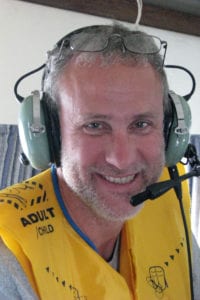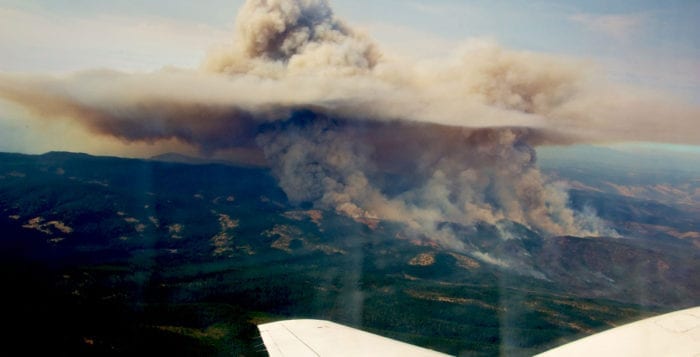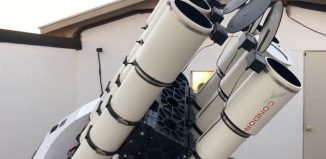BNL’s Sedlacek flies the not-so-friendly skies
The search for small particles has taken Arthur Sedlacek to places like thick plumes of smoke above wildfires raging in the western United States to picturesque vistas on Ascension Island, a staging area for the Allies for antisubmarine activities during World War II.
A chemist in the Environmental and Climate Sciences Department at Brookhaven National Laboratory, Sedlacek is studying aerosols, which are tiny particles suspended in the atmosphere. These particles can form the nuclei of clouds. Depending on their color, they can also either heat or cool the atmosphere.
“White” aerosols, as Sedlacek put it, such as sulfate- or nitrate-based particles, reflect solar radiation, while “black” aerosols, such as soot, absorb the sun’s light and help trap that energy in the atmosphere. By absorbing heat, darker aerosols increase the temperature, while lighter particles reflect some of that heat back into space.
“When you talk about climate change, you identify greenhouse gases, most notably carbon dioxide, which is responsible for warming,” Sedlacek said. “When you run through the model calculations, the models overpredict what we should see. Either something is wrong with the models or something else is counterbalancing the warming effect.”

Indeed, aerosols represent part of that something else. “We need to incorporate them into our models to better understand what we actually observe in the field,” Sedlacek said. He studies the types of particles, how they age, their color, changes in their color and whether they can act as cloud condensation nuclei.
“We want to understand what’s being produced and how it changes as the plume dilutes and gets older,” Sedlacek said. “How this aging alters the microphysical and optical [properties are] very important to quantifying the contribution of aerosol to climate change.”
During the summer and fall of 2013, Sedlacek was a part of a study called the Biomass Burn Observation Project, which included 14 scientists from seven institutions. Other BNL scientists included his co-principal investigator and chemist Larry Kleinman, atmospheric scientist Ernie Lewis, chemist Stephen Springston and tenured scientist Jian Wang.
Sedlacek spent several hours preparing the equipment that would gather data above these raging fires.
The planes flew into the smoke and then moved in the direction of the smoke, measuring the changes in these aerosols an hour, two hours and more away from the fire. These measurements showed how these aerosols changed over time.
While the study was conducted several years ago, Sedlacek and his colleagues are still working to put together the information.
They have learned that the particles in the air change dramatically in the first few hours. Biomass burning events produce aerosols that are considered “brown carbon” because they are not black, like soot, but they aren’t white like a sulfate- or nitrate-containing aerosol.
Brown carbon is known to evolve. They also observed a particle type referred to as “tar balls.” While others have seen these, Sedlacek and his colleagues are the first to show that they behave like secondary organic aerosols.
The description of these tar balls isn’t meant to suggest boulder-sized pieces of tar hiding somewhere in the clouds: They are about 250 nanometers in diameter, which makes them about 240 times smaller than the thickness of a human hair.
The group is trying to understand how these tar balls form. These tar balls may help clarify a sampling mystery. The top-down view, from satellites, suggests something different than the bottom-up view, from collecting data from particles. The satellite views indicate there should be more “stuff” in the air.
The bottom-up view may not take these tar balls into account. Not all wildfires produce tar balls, but the data Sedlacek and his collaborators collected suggest that they could represent 20 to 30 percent of the particulate mass in the plume.
In addition to flying above wildfires, Sedlacek also jets to places around the world including Brazil and Ascension Island.
He is also a mentor for two instruments, which means he is responsible for making sure they are functioning. He works with single-particle soot photometers, which measure the amount of black carbon in the air, and the aethalometer, which uses light transmission to determine the concentration of black carbon particles collected on a filter.
With the single-particle soot photometer, Sedlacek looked “at the data in a new way and from that gained insight into the morphology — the shape — of the individual particles, something that nobody had thought to do previously,” Lewis explained in an email. Lewis, who has known Sedlacek for over 10 years and has collaborated on numerous projects, said that Sedlacek is “wonderful to work with” and is a “very careful scientist with keen insight and great attention to detail.”
On Ascension Island, Sedlacek was a mentor in support of another scientist’s field campaign. That effort is exploring how biomass burning aerosols produced in Africa interact with marine clouds as the air mass moves from the west coast of Africa in the general direction of the island.
A photographer and bicyclist, Sedlacek takes numerous pictures of his work.
Sedlacek describes himself as an experimentalist and an observationist. He does not do any of the climate models. His data, however, informs those models and enables other scientists to include more details about the climate and atmosphere.
“Those of us who love to fly get to fly into these plumes,” where they are in an unpressurized cabin, so the outside air makes its way into the plane, he said. They experience considerable turbulence above these fires.
“When we see our instruments and our senses respond at the same time,” he said, “it makes for an unforgettable experience.”







